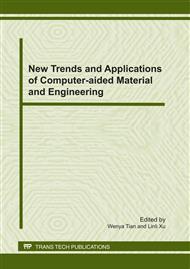[1]
A. Erturk, H.N. Ozguven, E. Budak, Analytical modeling of spindle–tool dynamics on machine tools using Timoshenko beam model and receptance coupling for the prediction of tool point FRF International Journal of Machine Tools & Manufacture 46 (2006).
DOI: 10.1016/j.ijmachtools.2006.01.032
Google Scholar
[2]
Jaspreet S. Dhupia, Bartosz Powalka, A. Galip Ulsoy, et al. Effect of a nonlinear joint on the dynamic performance of a machine tool. Journal of Manufacturing Science and Engineering, 2007, 129(5): 943-950.
DOI: 10.1115/1.2752830
Google Scholar
[3]
A. Erturk, H.N. Ozguven, E. Budak. Effect analysis of bearing andinterface dynamics on tool point FRF for chatter stability in machine tools by using a new analytical model for spindle–tool assemblies[J], International Journal of Machine Tools & Manufacture 47 (2007).
DOI: 10.1016/j.ijmachtools.2006.03.001
Google Scholar
[4]
Hamid Ahmadian, Mostafa N, Tool point dynamics prediction by a three-component model utilizing distributed joint interfaces[J], International Journal of Machine Tools & Manufacture 50 (2010) 998–1005.
DOI: 10.1016/j.ijmachtools.2010.07.003
Google Scholar
[5]
Keivan Ahmadi, Hamid Ahmadian. Modelling machine tool dynamics using a distributed parameter tool- holder joint interface. International Journal of Machine Tools & Manufacture, 2007, 47(12): 1916-(1928).
DOI: 10.1016/j.ijmachtools.2007.03.004
Google Scholar
[6]
Zaeh, M. Siedl, D, 2007, A new method for simulation of machining performance by integrating finite element and multi-body simulation for machine tools, Annals of the CIRP. 383-386. Vol. 56/1.
DOI: 10.1016/j.cirp.2007.05.089
Google Scholar
[7]
G.P. Zhang , Y.M. Huang, W.H. Shi, W.P. Fu, Predicting dynamic behaviors of a whole machine tool structure based on computer-aided engineering, International Journal of Machine Tools & Manufacture 43 (2003) 699–706.
DOI: 10.1016/s0890-6955(03)00026-9
Google Scholar
[8]
Zr H, Oertli, T, 2004, Finite Element Modeling of Ball Screw Feed Drive Systems, Annals of the CIRP, 53/1: 289-294.
DOI: 10.1016/s0007-8506(07)60700-8
Google Scholar
[9]
Mehdi Namazi. Mechanics and Dynamics of The Tool Holder - Spindle Interface[D], The University of British Columbia, (2006).
Google Scholar


